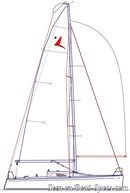Figaro 2
Sailboat specifications
The Figaro 2 is a 33’2” (10.11m) single handed racing sailboat designed by Marc Lombard Yacht Design Group (France). She was built between 2003 and 2015 by Bénéteau (France).
Figaro 2's main features
- Model
- Figaro 2
- Hull type
- Monohull
- Category
- Single handed offshore racing sailboat
- Sailboat builder
- Sailboat designer
- Country
- France
- Construction
- GRP (glass reinforced polyester):
Sandwich balsa fiberglass vinylester (vacuum infusion) - First built hull
- 2003
- Last built hull
- 2015
- Appendages
- Keel : fin with bulb
- Helm
- Single tiller
- Rudder
- Twin spade rudders
- Unsinkable
- No
- Trailerable
- No
- Standard public price ex. VAT (indicative only)
- N/A €
Figaro 2's main dimensions
- Overall length
- 33’ 4”10.15 m
- Hull length
- 33’ 2”10.11 m
- Waterline length
- 32’ 2”9.82 m
- Beam (width)
- 11’ 4”3.43 m
- Waterline beam (width)
- 8’ 2”2.5 m
- Draft
- 7’ 1”2.15 m
- Mast height from DWL
- 51’ 5”15.68 m
- Light displacement (MLC)
- 6680 lb3030 kg
- Maximum displacement (MLDC)
- 7937 lb3600 kg
- Ballast weight
- 2425 lb1100 kg
- Ballast type
- Cast iron fin with lead bulb
- Water ballast
- Lateral water ballasts
- Water ballast capacity
- 258.1 gal220 liters
Figaro 2's rig and sails
- Upwind sail area
- 732 ft²68 m²
- Downwind sail area
- 1324 ft²123 m²
- Mainsail area
- 409 ft²38 m²
- Genoa area
- 323 ft²30 m²
- Symmetric spinnaker area
- 915 ft²85 m²
- IiFore triangle height (from mast foot to fore stay top attachment)
- 42’ 8”13.03 m
- JiFore triangle base (from mast foot to bottom of forestay)
- 12’ 5”3.79 m
- PiMainsail hoist measurement (from tack to head)
- 42’ 8”13 m
- EiMainsail foot measurement (from tack to clew)
- 15’ 5”4.7 m
- Rigging type
- Sloop Marconi 7/8
- Mast configuration
- Deck stepped mast
- Rotating spars
- No
- Number of levels of spreaders
- 2
- Spreaders angle
- 20 °
- Spars construction
- Carbon fiber mast and aluminum boom
- Standing rigging
- Single-strand (ROD)
Figaro 2's performances
- HN (French rating)iHN or "Handicap Nationale" is an empirical rating system used in France allowing various monohulls, of different sizes and designs, to race each other fairly. It is particularly suitable for cruiser and cruiser-racer. Therefore, by comparing these values, we can have an indication of the relative speed of 2 boats.
- 29.0
- Upwind sail area to displacementiThe ratio sail area to displacement is obtained by dividing the sail area by the boat's displaced volume to the power two-thirds.
The ratio sail area to displacement can be used to compare the relative sail plan of different sailboats no matter what their size.
Upwind: under 18 the ratio indicates a cruise oriented sailboat with limited performances especially in light wind, while over 25 it indicates a fast sailboat. - 350 ft²/T32.47 m²/T
- Downwind sail area to displacementiThe ratio sail area to displacement is obtained by dividing the sail area by the boat's displaced volume to the power two-thirds.
The ratio sail area to displacement can be used to compare the relative sail plan of different sailboats no matter what their size. - 632 ft²/T58.74 m²/T
- Displacement-length ratio (DLR)iThe Displacement Length Ratio (DLR) is a figure that points out the boat's weight compared to its waterline length. The DLR is obtained by dividing the boat's displacement in tons by the cube of one one-hundredth of the waterline length (in feet).
The DLR can be used to compare the relative mass of different sailboats no matter what their length:
a DLR less than 180 is indicative of a really light sailboat (race boat made for planning), while a DLR greater than 300 is indicative of a heavy cruising sailboat. - 91
- Ballast ratioiThe Ballast ratio is an indicator of stability; it is obtained by dividing the boat's displacement by the mass of the ballast. Since the stability depends also of the hull shapes and the position of the center of gravity, only the boats with similar ballast arrangements and hull shapes should be compared.
The higher the ballast ratio is, the greater is the stability. - 36 %
- Critical hull speediAs a ship moves in the water, it creates standing waves that oppose its movement. This effect increases dramatically the resistance when the boat reaches a speed-length ratio (speed-length ratio is the ratio between the speed in knots and the square root of the waterline length in feet) of about 1.2 (corresponding to a Froude Number of 0.35) . This very sharp rise in resistance, between speed-length ratio of 1.2 to 1.5, is insurmountable for heavy sailboats and so becomes an apparent barrier. This leads to the concept of "hull speed".
The hull speed is obtained by multiplying the square root of the waterline length (in feet) by 1.34. - 7.61 knots
Figaro 2's auxiliary engine
- Engine(s)
- 1 inboard engine
- Engine(s) power
- 20 HP
- Fuel type
- Diesel
- Fuel tank capacity
- 10.6 gal40 liters
Figaro 2's accommodations and layout
- Cockpit
- Open aft cockpit
- Berth(s)
- 4
Similar sailboats that may interest you:
Sailboats
First built hull
Hull length
2015
36’ 1”10.99 m
2003
31’ 6”9.6 m
2007
40’12.18 m
2017
32’9.75 m
1994
29’ 6”8.98 m
2016
35’ 10”10.9 m
2017
40’12.2 m
2013
28’ 7”8.72 m
2019
37’ 1”11.3 m
2014
32’ 10”9.99 m
2019
30’9.14 m
2013
29’ 2”8.9 m
1999
31’ 4”9.54 m
2008
32’ 8”9.98 m
2012
36’ 5”11.1 m



